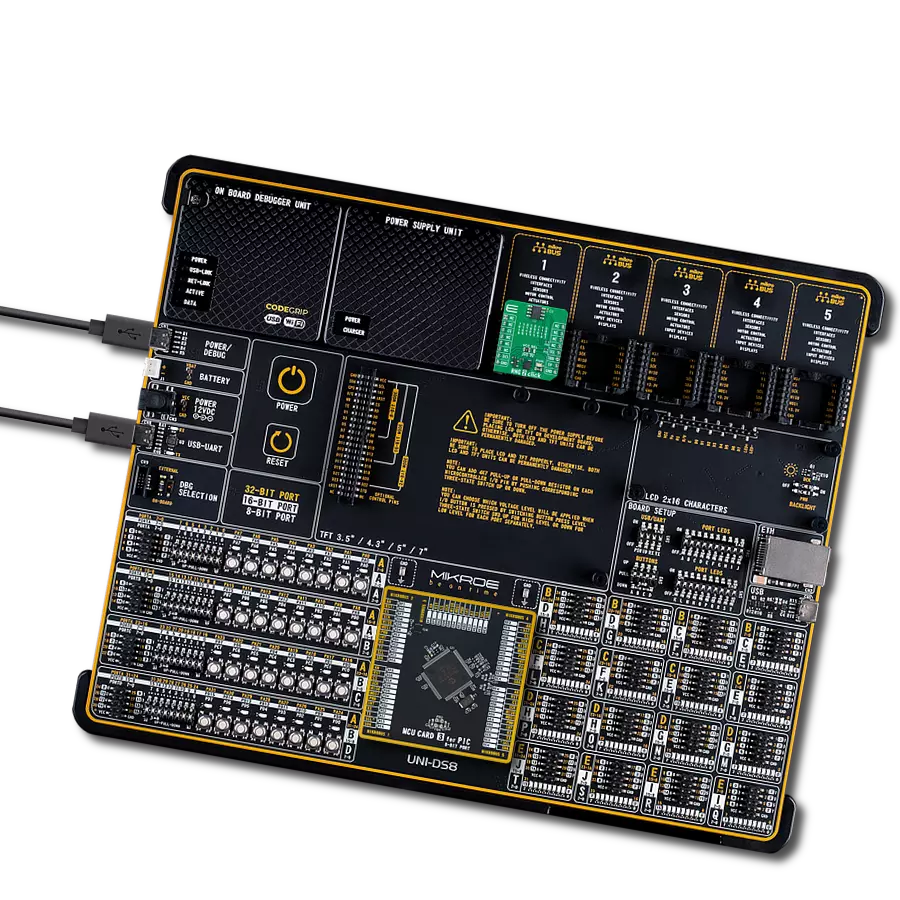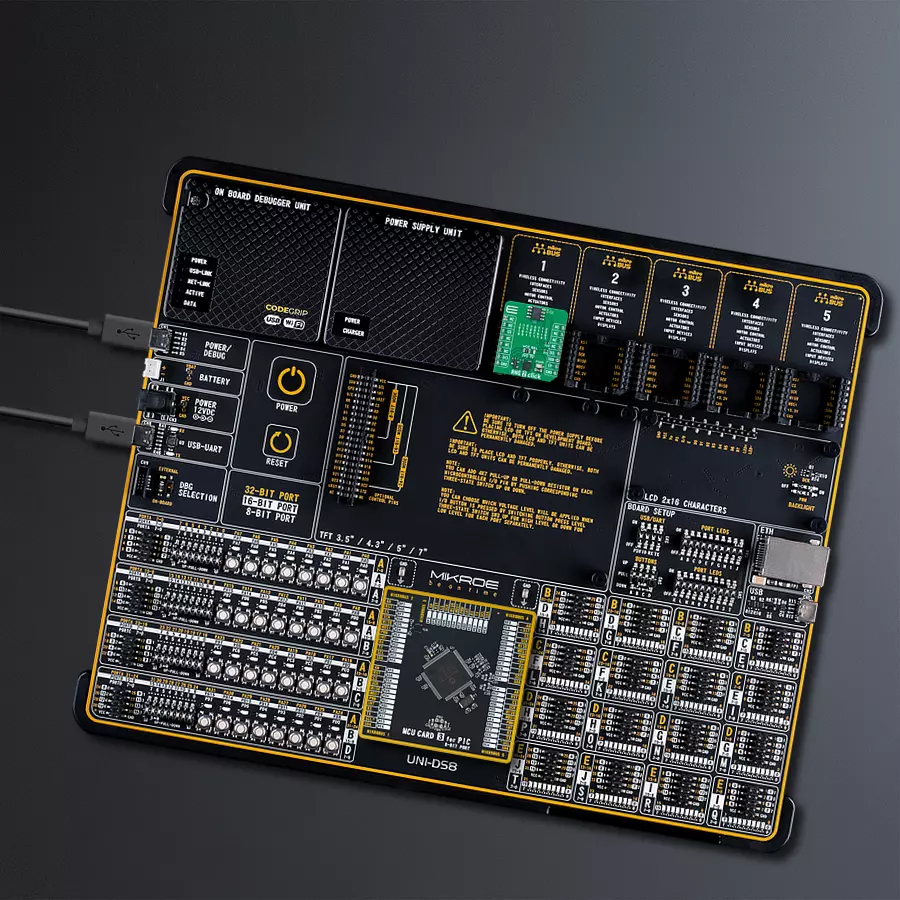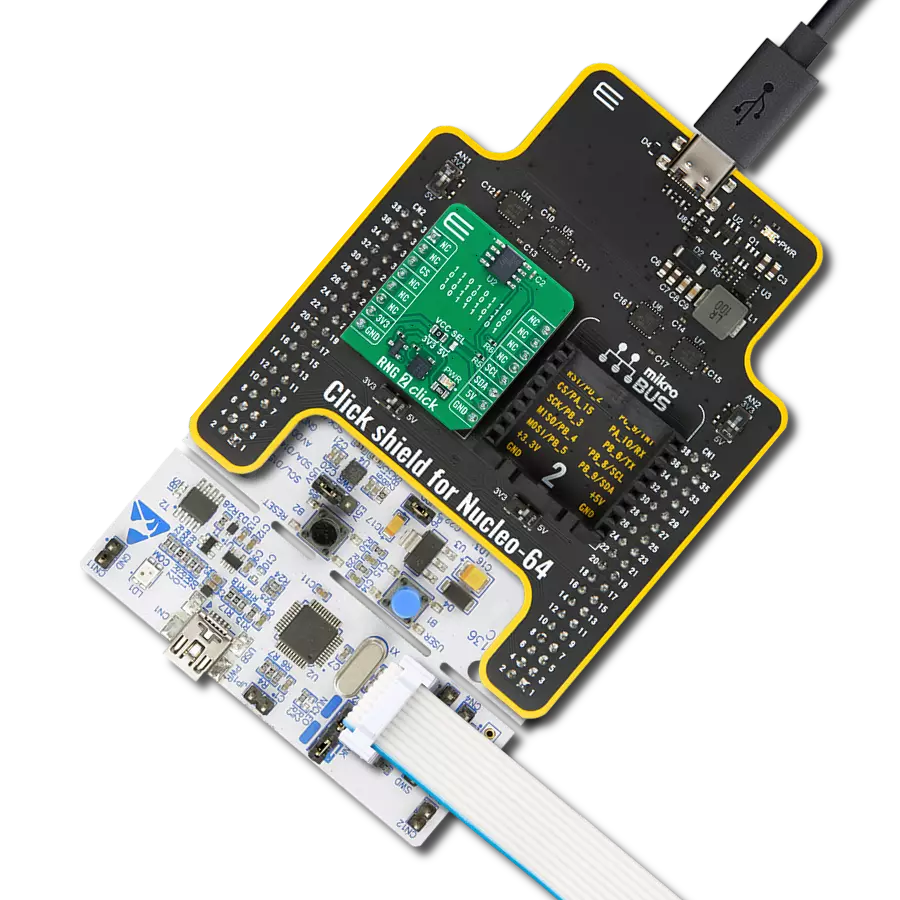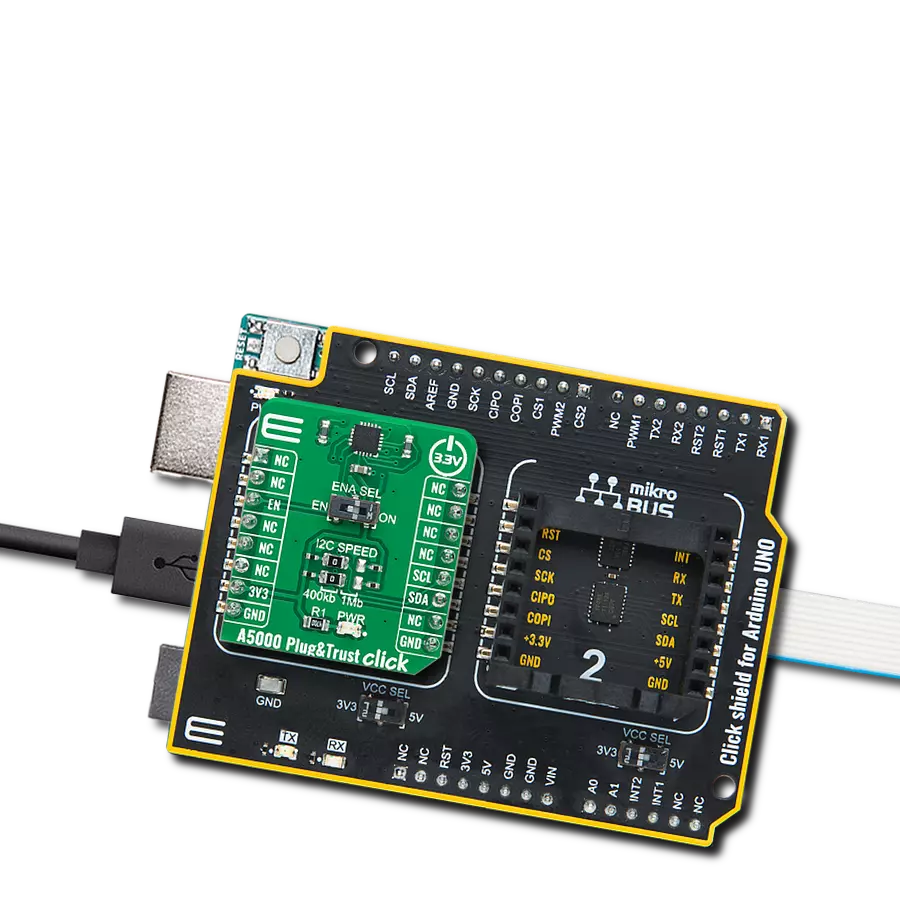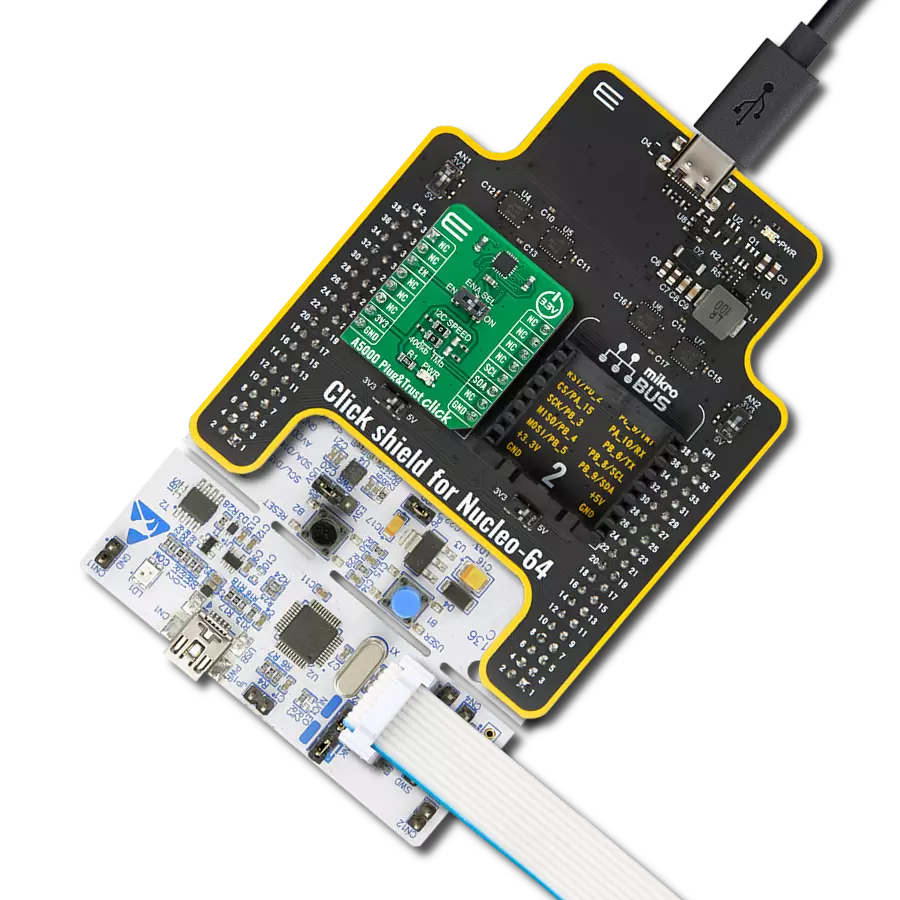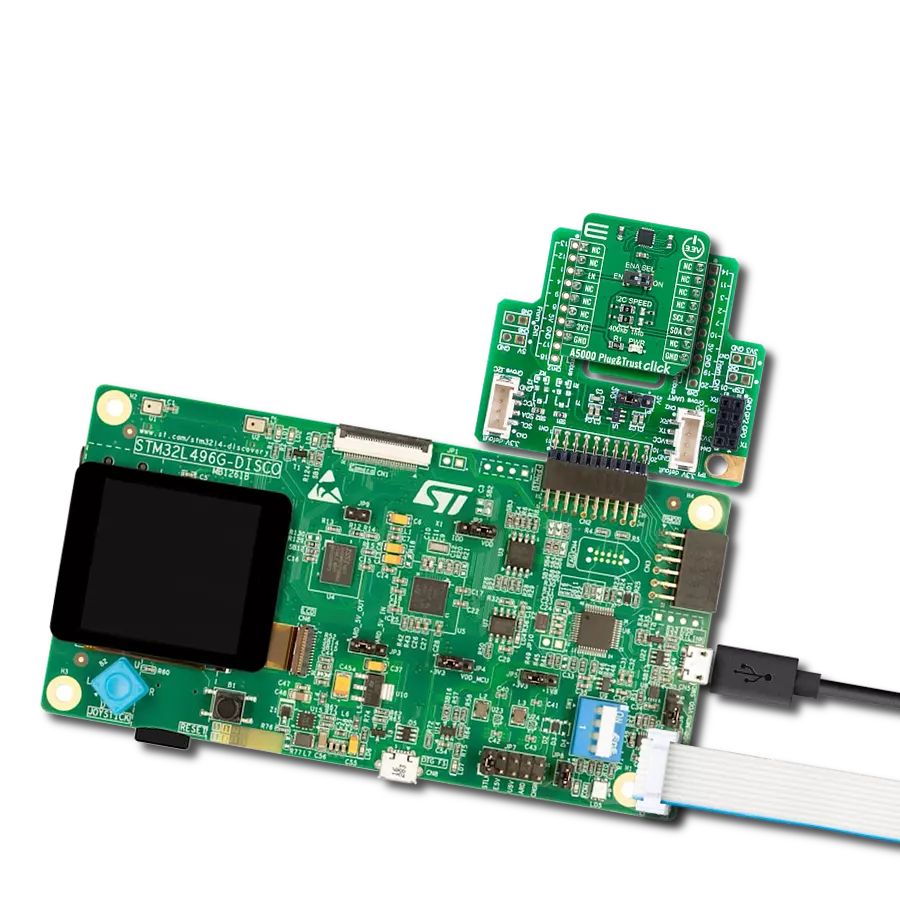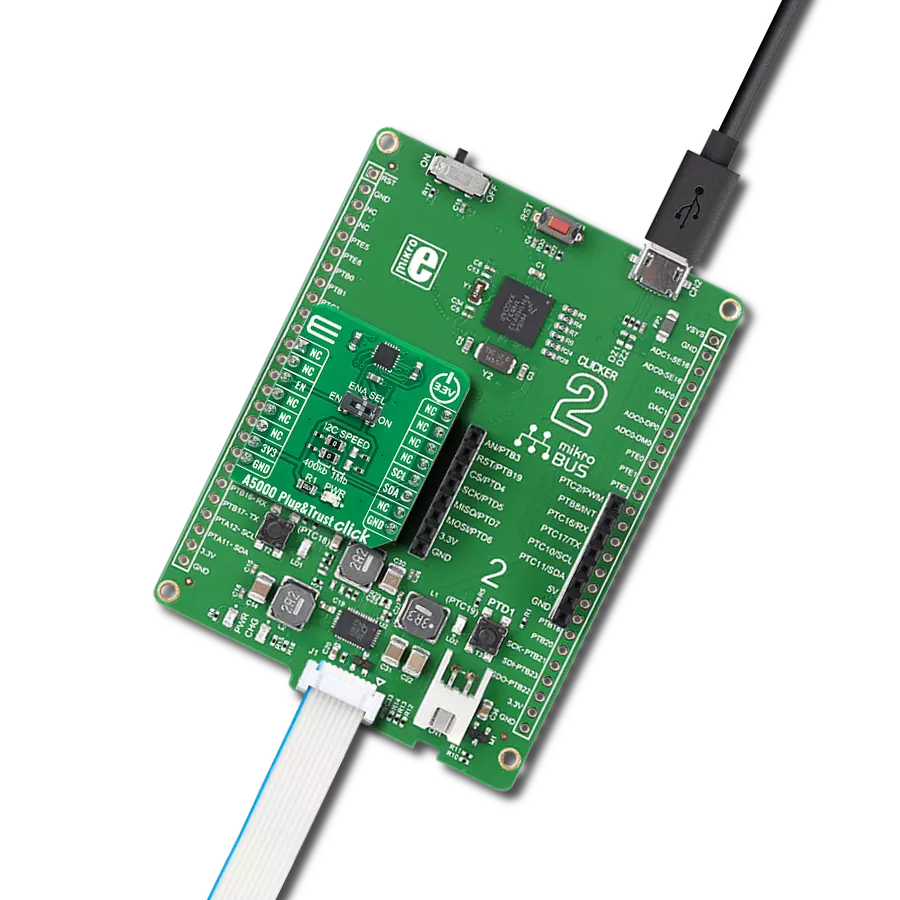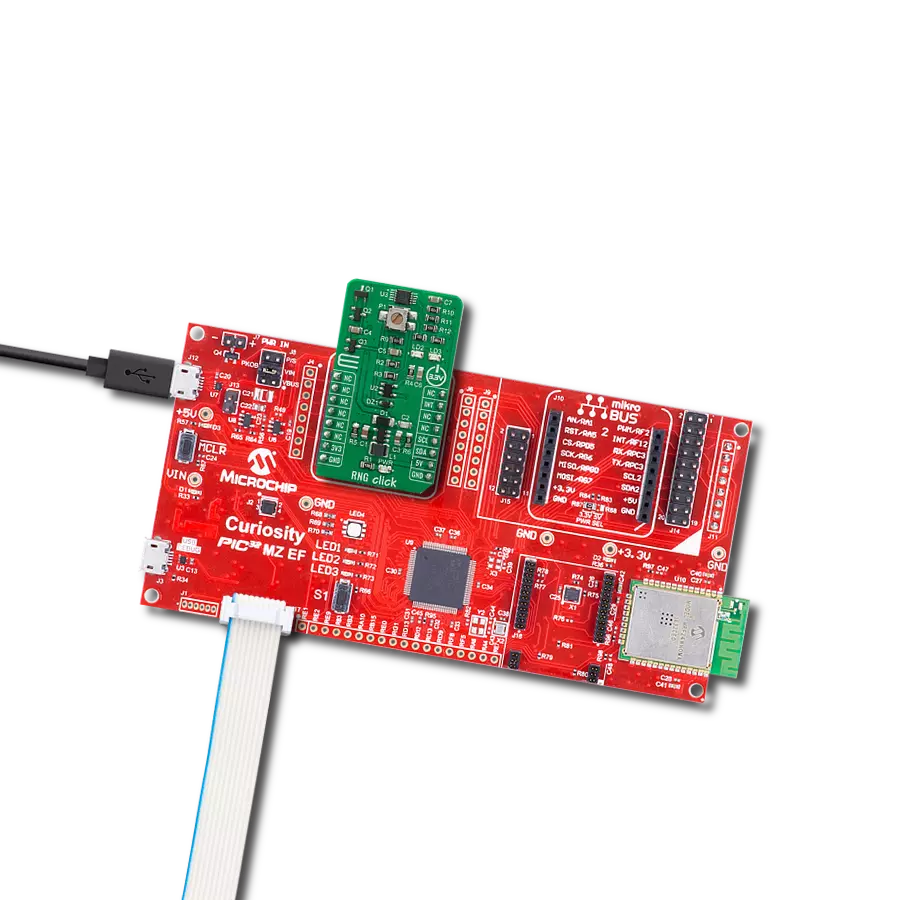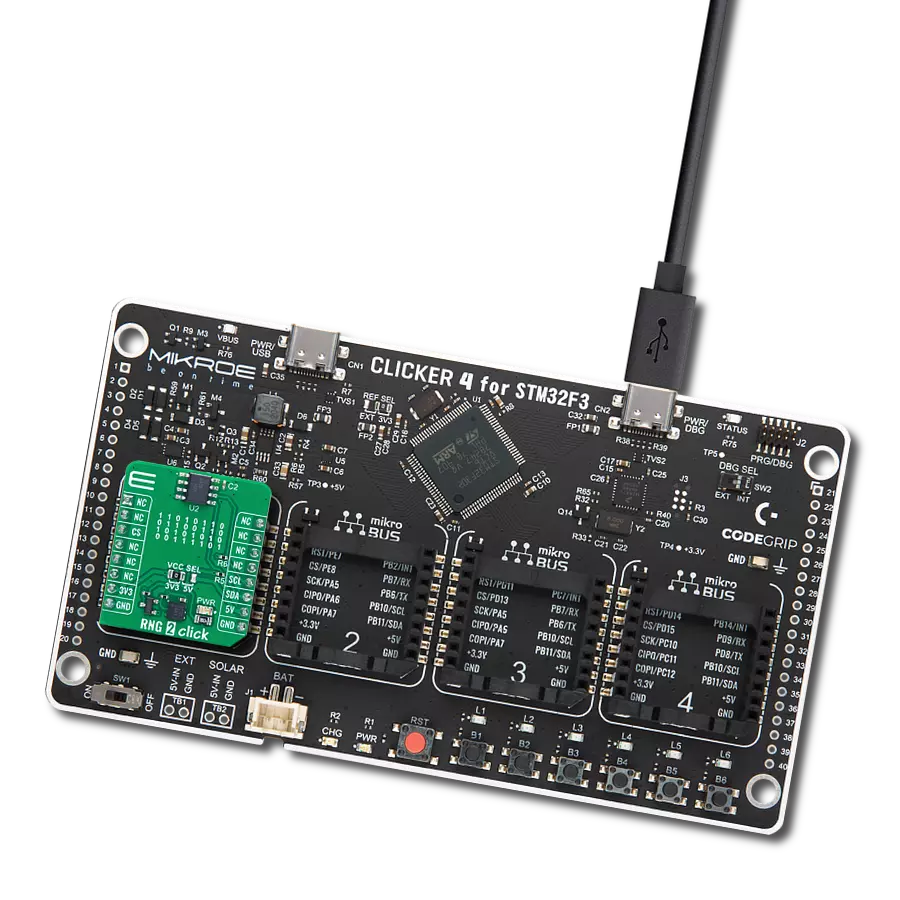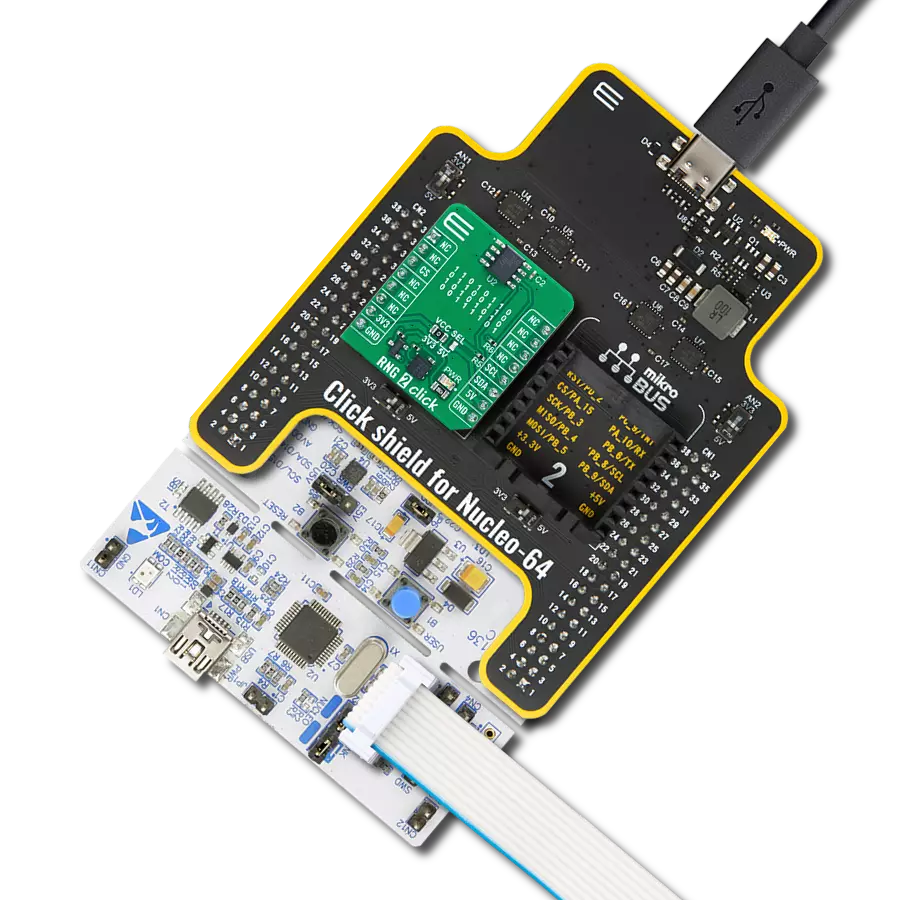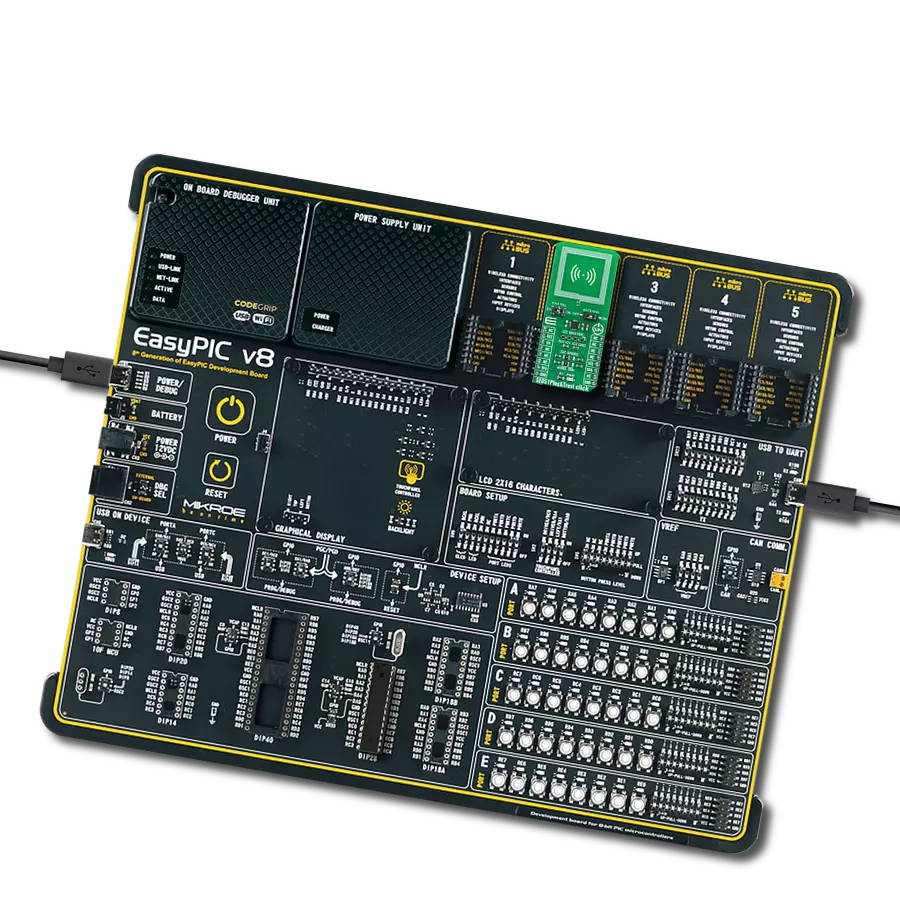Secure, NIST-certified 256-bit random number generation with tamper detection
A
A
Hardware Overview
How does it work?
RNG 2 Click is based on the RNG90, a secure Random Number Generator (RNG) from Microchip fully compliant with the NIST SP 800-90A/B/C standards. This Click board™ is designed to meet the stringent requirements of modern cryptographic systems, where the strength of generated random numbers directly influences the overall system security. True random number generation is critical in cryptographic applications such as key generation, digital signatures, password creation, nonce generation, random challenges, and initialization vectors. The RNG90 IC addresses these needs by producing a 256-bit random number with each Random command execution, offering a robust security strength of 128 bits. Independently
validated for randomness through a NIST-certified laboratory, the RNG90 guarantees trustworthy operation in sensitive applications. As part of Microchip’s CryptoAuthentication™ product line, it integrates into systems demanding secure, ready-to-use randomness without requiring any additional configuration. RNG 2 Click communicates over a standard I2C interface operating at up to 400kHz, making it simple to integrate with a wide range of host MCUs. It also features a unique 72-bit serial number and advanced hardware-based security mechanisms such as an active shield for protection against invasive physical attacks, tamper detection for abnormal voltage conditions, and temperature-based tamper monitoring. With these features,
RNG 2 Click is ideally suited for use in cryptographic systems, password management tools, gaming platforms, cryptocurrency hardware wallets, scientific experiments, and even aerospace and defense technologies, where secure and certified random number generation is a fundamental requirement. This Click board™ can operate with either 3.3V or 5V logic voltage levels selected via the VCC SEL jumper. This way, both 3.3V and 5V capable MCUs can use the communication lines properly. Also, this Click board™ comes equipped with a library containing easy-to-use functions and an example code that can be used as a reference for further development.
Features overview
Development board
UNI-DS v8 is a development board specially designed for the needs of rapid development of embedded applications. It supports a wide range of microcontrollers, such as different STM32, Kinetis, TIVA, CEC, MSP, PIC, dsPIC, PIC32, and AVR MCUs regardless of their number of pins, and a broad set of unique functions, such as the first-ever embedded debugger/programmer over WiFi. The development board is well organized and designed so that the end-user has all the necessary elements, such as switches, buttons, indicators, connectors, and others, in one place. Thanks to innovative manufacturing technology, UNI-DS v8 provides a fluid and immersive working experience, allowing access anywhere and under any
circumstances at any time. Each part of the UNI-DS v8 development board contains the components necessary for the most efficient operation of the same board. An advanced integrated CODEGRIP programmer/debugger module offers many valuable programming/debugging options, including support for JTAG, SWD, and SWO Trace (Single Wire Output)), and seamless integration with the Mikroe software environment. Besides, it also includes a clean and regulated power supply module for the development board. It can use a wide range of external power sources, including a battery, an external 12V power supply, and a power source via the USB Type-C (USB-C) connector. Communication options such as USB-UART, USB
HOST/DEVICE, CAN (on the MCU card, if supported), and Ethernet is also included. In addition, it also has the well-established mikroBUS™ standard, a standardized socket for the MCU card (SiBRAIN standard), and two display options for the TFT board line of products and character-based LCD. UNI-DS v8 is an integral part of the Mikroe ecosystem for rapid development. Natively supported by Mikroe software tools, it covers many aspects of prototyping and development thanks to a considerable number of different Click boards™ (over a thousand boards), the number of which is growing every day.
Microcontroller Overview
MCU Card / MCU
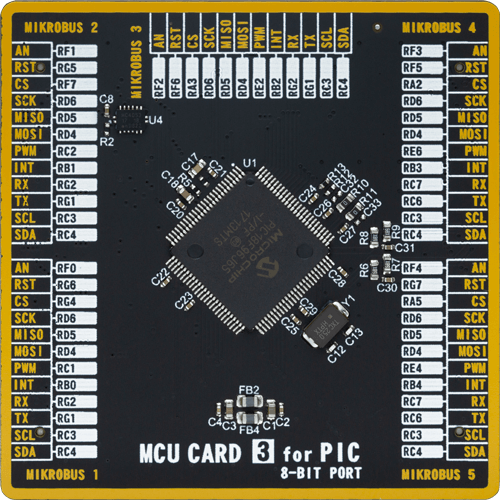
Type
8th Generation
Architecture
PIC
MCU Memory (KB)
96
Silicon Vendor
Microchip
Pin count
100
RAM (Bytes)
3808
Used MCU Pins
mikroBUS™ mapper
Take a closer look
Click board™ Schematic
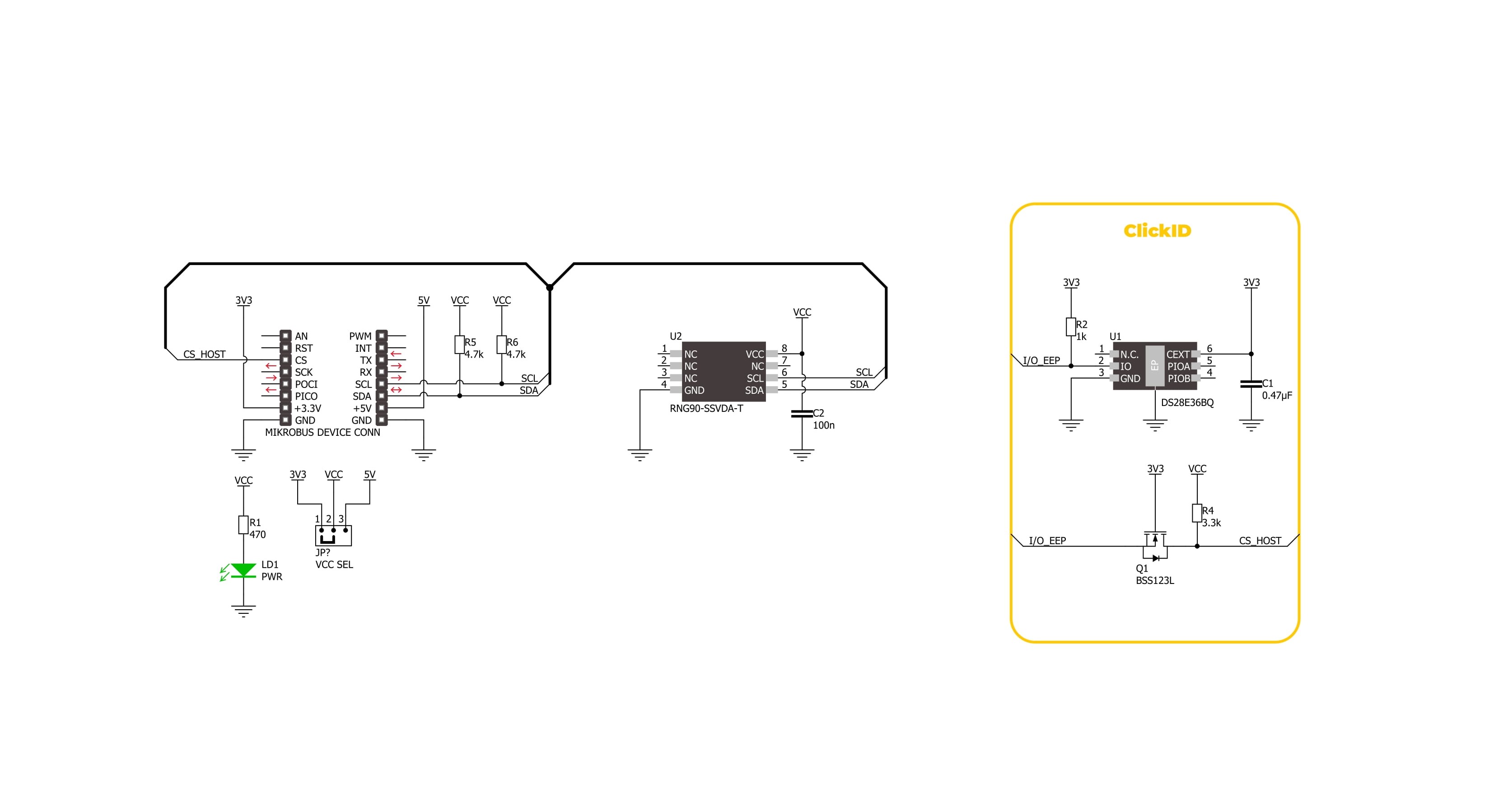
Step by step
Project assembly
Software Support
Library Description
RNG 2 Click demo application is developed using the NECTO Studio, ensuring compatibility with mikroSDK's open-source libraries and tools. Designed for plug-and-play implementation and testing, the demo is fully compatible with all development, starter, and mikromedia boards featuring a mikroBUS™ socket.
Example Description
This example demonstrates the use of the RNG 2 Click board by periodically reading and logging random numbers generated by the device.
Key functions:
rng2_cfg_setup- This function initializes Click configuration structure to initial values.rng2_init- This function initializes all necessary pins and peripherals used for this Click board.rng2_default_cfg- This function executes a default configuration of RNG 2 Click board.rng2_read_random_num- This function requests and reads a 32-byte random number from the RNG 2 Click board.
Application Init
Initializes the logger and the Click board driver, then applies the default configuration.
Application Task
Reads and displays a 32-byte random number from the device every second.
Open Source
Code example
The complete application code and a ready-to-use project are available through the NECTO Studio Package Manager for direct installation in the NECTO Studio. The application code can also be found on the MIKROE GitHub account.
/*!
* @file main.c
* @brief RNG 2 Click example
*
* # Description
* This example demonstrates the use of the RNG 2 Click board by periodically reading
* and logging random numbers generated by the device.
*
* The demo application is composed of two sections :
*
* ## Application Init
* Initializes the logger and the Click board driver, then applies the default configuration.
*
* ## Application Task
* Reads and displays a 32-byte random number from the device every second.
*
* @author Stefan Filipovic
*
*/
#include "board.h"
#include "log.h"
#include "rng2.h"
static rng2_t rng2;
static log_t logger;
void application_init ( void )
{
log_cfg_t log_cfg; /**< Logger config object. */
rng2_cfg_t rng2_cfg; /**< Click config object. */
/**
* Logger initialization.
* Default baud rate: 115200
* Default log level: LOG_LEVEL_DEBUG
* @note If USB_UART_RX and USB_UART_TX
* are defined as HAL_PIN_NC, you will
* need to define them manually for log to work.
* See @b LOG_MAP_USB_UART macro definition for detailed explanation.
*/
LOG_MAP_USB_UART( log_cfg );
log_init( &logger, &log_cfg );
log_info( &logger, " Application Init " );
// Click initialization.
rng2_cfg_setup( &rng2_cfg );
RNG2_MAP_MIKROBUS( rng2_cfg, MIKROBUS_1 );
if ( RNG2_OK != rng2_init( &rng2, &rng2_cfg ) )
{
log_error( &logger, " Communication init." );
for ( ; ; );
}
if ( RNG2_ERROR == rng2_default_cfg ( &rng2 ) )
{
log_error( &logger, " Default configuration." );
for ( ; ; );
}
log_info( &logger, " Application Task " );
}
void application_task ( void )
{
if ( RNG2_OK == rng2_read_random_num ( &rng2 ) )
{
log_printf ( &logger, " Random number: " );
for ( uint8_t cnt = 0; cnt < rng2.rsp_pkt.data_len; cnt++ )
{
log_printf ( &logger, "%.2X", ( uint16_t ) rng2.rsp_pkt.data_buf[ cnt ] );
}
log_printf ( &logger, "\r\n\n" );
}
Delay_ms ( 1000 );
}
int main ( void )
{
/* Do not remove this line or clock might not be set correctly. */
#ifdef PREINIT_SUPPORTED
preinit();
#endif
application_init( );
for ( ; ; )
{
application_task( );
}
return 0;
}
// ------------------------------------------------------------------------ END
Additional Support
Resources
Category:Encryption
